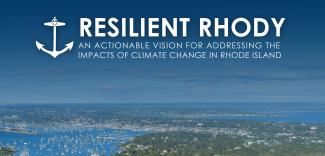Resilient Rhody
Rhode Island Statewide Coastal Resilience Plan
Rhode Island is planning for the future and we need your voice.
As our communities face increasing risks from sea level rise, extreme weather, and other impacts of climate change, the state is developing “Resilient Rhody 2025”, its first Statewide Coastal Resilience Plan. This plan will guide how we adapt and respond to these growing challenges. Community members, local organizations, and partners from across the state are invited to help shape this effort by joining our Community Forums.
Upcoming Events
Subscribe for Updates
Join our list to get the latest updates on climate resilience work in RI, including Resilient Rhody 2025 and upcoming events.
Sign up to Stay in Touch with Resilient RhodyRhode Island's First Comprehensive Climate Preparedness Strategy

On September 15, 2017, Governor Gina M. Raimondo signed an Executive Order appointing a Chief Resilience Officer to drive climate resilience efforts across the state, both within government and in collaboration with business, academic, and nonprofit partners, with the mission to develop a statewide Climate Resilience Action Strategy to be submitted to the Governor by July 1, 2018.
The goal of the Strategy is to identify actions - e.g., projects, policies and legislation, or funding and financing opportunities - that the state can take to better prepare for a changing climate. Rhode Islanders are seeing the impacts of climate change in our communities already so the actions included in the Strategy prioritize things we can begin work on now.
COASTAL
Shocks
- Severe Weather Events (e.g. hurricanes)
- High Wind
- Flooding
Stressors
- Sea level rise
- Aging infrastructure
- Spread of invasive species
- Coastal erosion
- Development pressure and assets in floodplains
Natural
- Coastal wetlands and marshland
- Aquaculture
- Harbors
- Rivers, bays
- Salt Marshes
- Beaches
- Forests
- Farmland
Infrastructure
- Water infrastructure
- Stormwater-related infrastructure
- Wastewater systems/treatment facilities
- Drinking water supply
- Transportation infrastructure
- Improve access to public transportation
- Roads and bridges, rails
- Food distribution
- Energy infrastructure
- Electric grid and power lines
- Inequitable access
Community
- Local organizations (churches, senior centers, libraries, schools)
- Local businesses
- Public recreation and natural areas / shoreline access
- Coastal way of life / culture / diversity / tourism
- Housing and historic properties, real estate values
- Underserved populations
Enhanced emergency preparedness
- Government/community communication and coordination
- Information for residents re: zone building requirements & flood insurance
- Communication enabled during storms
- Generators at essential facilities
- Clear evacuation routes and identified centers shelters
Education
- Community and business education re: resiliency, climate, emergency procedures
Others
- Sustainable funding and new financing mechanisms for resiliency
- Update building and zoning laws and codes to new climate projections
- Build local leadership for sustained interaction between community, business, and municipalities on climate resilience
UPLAND
Shocks
- Severe Weather Events (hurricanes, etc.)
- High Wind
- Flooding
- Forest Fires
Stressors
- Aging infrastructure
- Spread of invasive species / forest pests
- Drought
- Temperature swings
- Development pressure and assets in floodplains
Natural
- Farmland
- Forests
- Drinking water supply (reservoirs, private wells)
Infrastructure
- Bridges and roads
- Power grid
- Cell towers and communication network
- Dams (public and private)
- Stormwater infrastructure
- Wastewater treatment facilities
Community
- Public recreation and natural areas
- Hospitals, nursing homes
- Historic neighborhoods
Enhanced emergency preparedness
- Community communication/education
- Information re: emergency response and preparedness
- More evacuation routes, and clear communication re: evacuation routes
- Data and maps for upland flood risk and emergency response
- Robust communications network (internet, phone, cable)
- Continuity of services at emergency shelters during disruption
- Backup generators
Others
- Education to municipal staff and planning boards on climate change, resiliency, green infrastructure
- Updated zoning codes to reflect climate projections and vulnerabilities
- Increase access to public transportation
- Sustainable municipal funding and new financing strategies
- Staff expertise/training (high turnover and limited resources)
- Build local leadership for sustained interaction between community, business, and municipalities on climate resilience
If you are engaged on this issue, this is the place to interact with us as we continue to work toward climate resilience here in Rhode Island. Send us your feedback!
Learn more about the implementation of the Resilient Rhody Strategy here.